Transforming Brownfields as Tourism Destinations and Their Sustainability on the Example of Slovakia
Abstract
1. Introduction
- -
- have been affected by the former uses of the site and the surrounding land,
- -
- are derelict and underused,
- -
- may have real or perceived contamination problems,
- -
- are mainly in developed urban areas and require intervention to bring them back to beneficial use.
2. Aims and Hypotheses
3. Materials and Methods
4. Theoretical Background
We can state that post-industrial tourism is understood more broadly than mining tourism, which also follows from the conclusions of the World Tourism Organization (https://www.unwto.org/) and also from the works of other authors researching the issue, e.g., Stašáková and Kulla [57], C. Schejbal [58,59], J. Jelen [60].
4.1. Mining (Postmining) Brownfields
4.2. Mining Tourism
4.3. Revitalization of Postmining Brownfields for (Mining) Tourism
5. Results
This document briefly summarizes the importance of industrial (including minning) heritage, at the same time draws attention to its social values and defines the main priorities and ways of its protection, preservation and secondary use.[110]
5.1. Mining Brownfields in (Mining) Tourism in Slovakia
5.2. Questionnaire Survey
6. Discussion
The Position of Mining Brownfields in Mining Tourism, the Tourism Industry, and Their Sustainability
7. Conclusions
Author Contributions
Funding
Conflicts of Interest
Appendix A
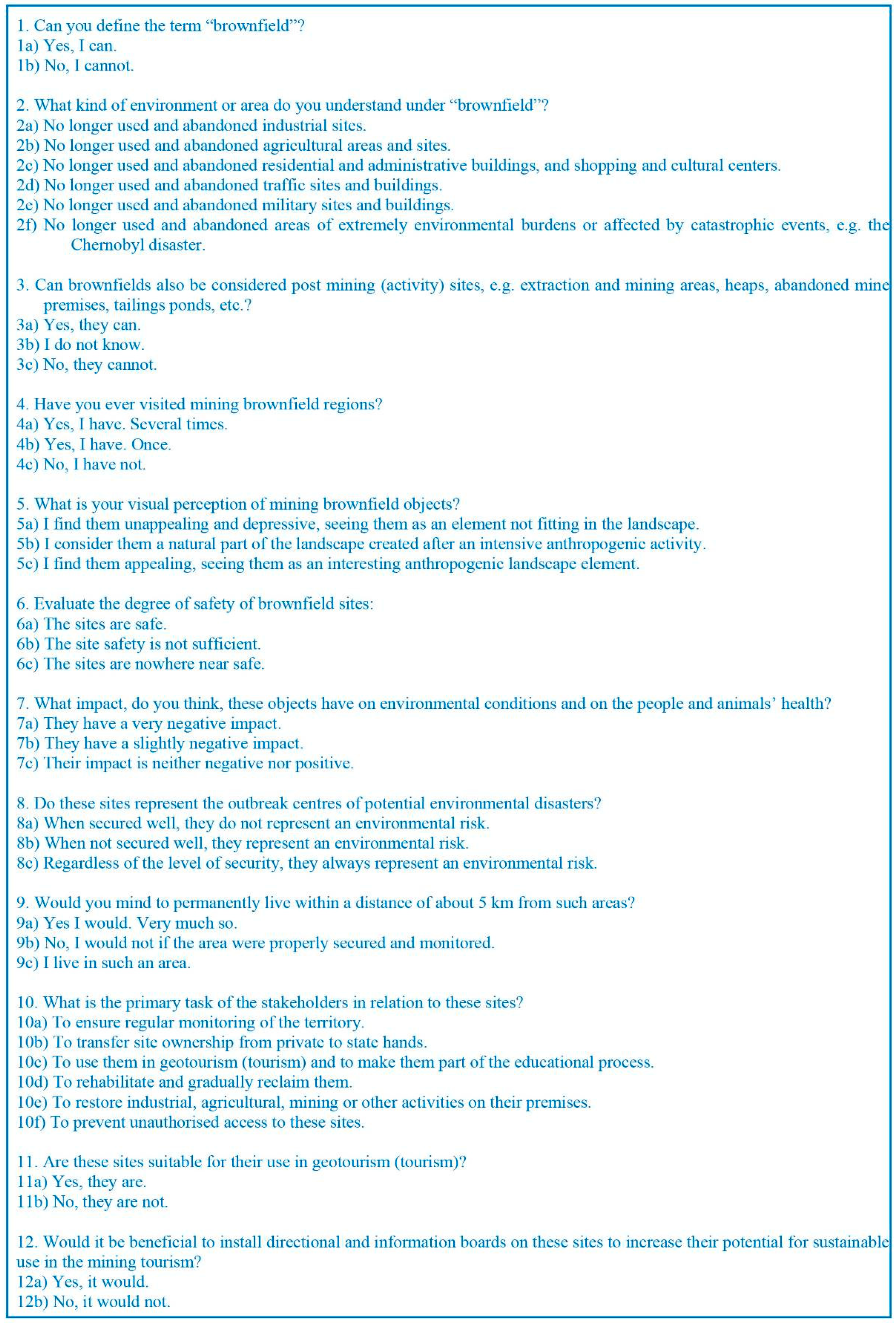

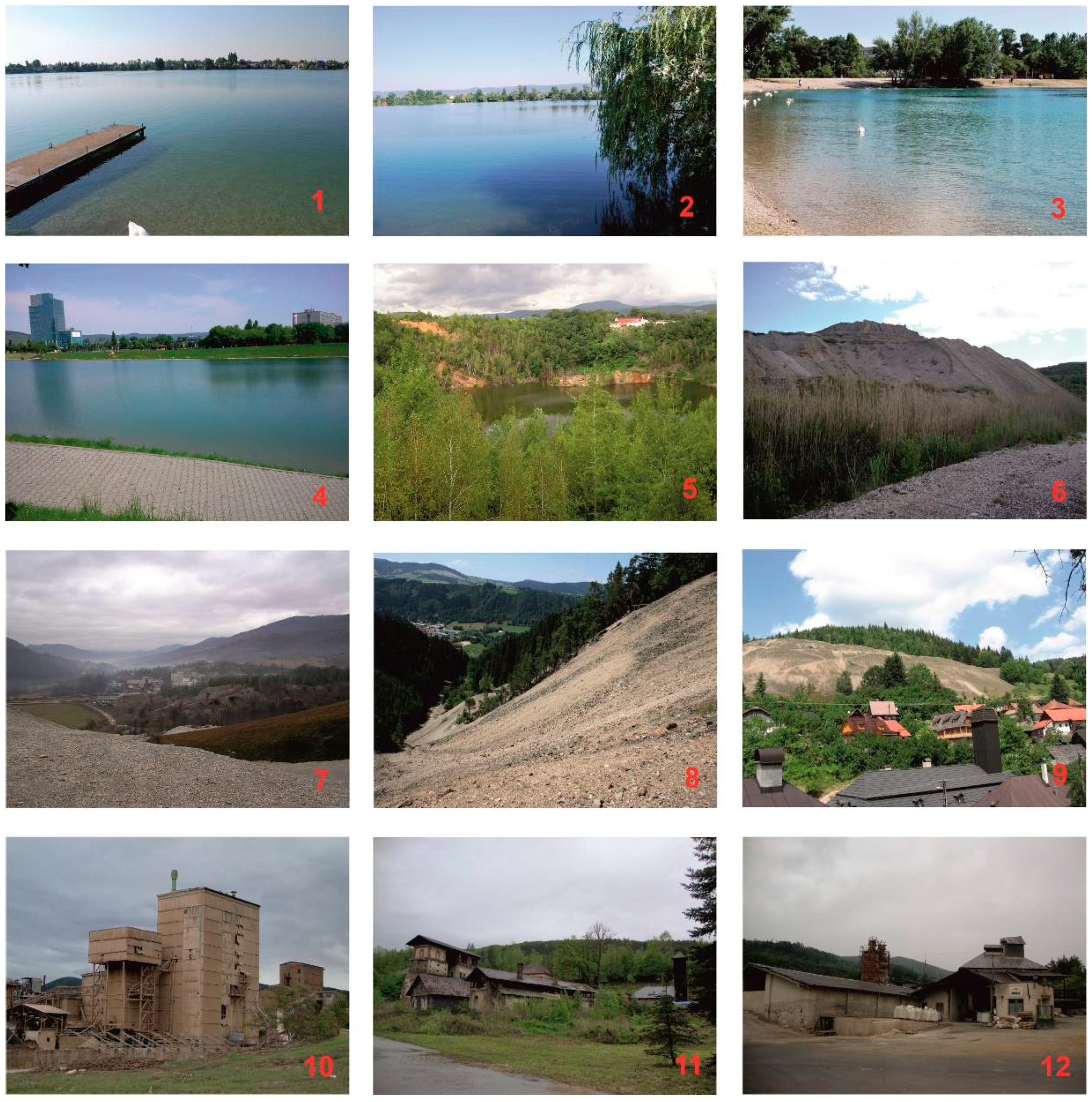

References
- CABERNET. Glossary of Terms for Holistic Management of Brownfield Regeneration. Available online: https://www.cen.eu/work/areas/env/Pages/WS-74.aspx (accessed on 20 March 2018).
- Heasman, I.; Westcott, F.; Connell, P.; Visser-Westerweele, E.L.; MacKay, S. (Eds.) Environmental Liability Transfer in Europe: Divestment of Contaminated Land for Brownfield Regeneration; Report; NICOLE: Rotterdam, The Netherlands, 2011; p. 55. [Google Scholar]
- Ferber, U.; Grimski, D.; Millar, K.; Nathanail, P. Sustainable Brownfield Regeneration: CABERNET Network Report; The Concerted Action on Brownfield and Economic Regeneration Network: Nottingham, UK, 2006. [Google Scholar]
- Parliamentary Office of Science and Technology. A Brown and Pleasant Land; POST: London, UK, 1998. [Google Scholar]
- Pavolová, H.; Kysel’ová, K.; Bakalár, T. Brownfields as a tool for support of Destination Tourism development. Acta Geotur. 2012, 3, 26–30. [Google Scholar]
- Pavolová, H.; Bakalár, T.; Emhemed, E.M.A.; Hajduová, Z.; Pavčo, M. Model of sustainable regional development with implementation of brownfield areas. Entrep. Sustain. Issues 2019, 6, 1088–1100. [Google Scholar] [CrossRef]
- Oliver, L.; Ferber, U.; Grimski, D.; Millar, K.; Nathanail, P. The Scale and Nature of European Brownfields. Available online: https://www.researchgate.net/publication/228789048_The_Scale_and_Nature_of_European_Brownfield (accessed on 23 March 2020).
- Darmendrail, D. Pollution des Sols: Basol. Available online: http://basol.developpement-durable.gouv.fr/faq.htm#q9 (accessed on 20 March 2018).
- Freier, K. Brownfield Redevelopment Workplan; German Environmental Agency: Berlin, Germany, 1998. [Google Scholar]
- Cehlár, M.; Janočko, J.; Šimková, Z.; Pavlik, T.; Tyulenev, M.; Zhironkin, S.; Gasanov, M. Mine Sited after Mine Activity: The Brownfields Methodology and Kuzbass Coal Mining Case. Resources 2019, 8, 21. [Google Scholar] [CrossRef]
- USEPA. Available online: https://www.epa.gov/brownfields/overview-epas-brownfields-program (accessed on 23 March 2018).
- De Sousa, C.A. Brownfield redevelopment in Toronto: An examination of past trends and future prospects. Land Use Policy 2002, 19, 297–309. [Google Scholar] [CrossRef]
- Newton, P.W. Beyond greenfield and brownfield: The challenge of regenerating Australia’s greyfield suburbs. Built Environ. 2010, 36, 81–104. [Google Scholar] [CrossRef]
- Potts, L.; Cloete, C.E. Developing guidelines for brownfield development in South Africa. Environ. Impact 2012, 162, 389–399. [Google Scholar]
- Mert, Y. Contribution to sustainable development: Re-development of post-mining brownfields. J. Clean. Prod. 2019, 240, 10. [Google Scholar] [CrossRef]
- Ahmad, N.; Zhu, Y.; Ibrahim, M.; Waqas, M.; Waheed, A. Development of a Standard Brownfield Definition, Guidelines, and Evaluation Index System for Brownfield Redevelopment in Developing Countries: The Case of Pakistan. Sustainability 2018, 10, 4347. [Google Scholar] [CrossRef]
- Hollander, J.; Kirkwood, N.; Gold, J. Principles of Brownfield Regeneration: Cleanup, Design, and Reuse of Derelict Land; Island Press: Washington, DC, USA, 2010; p. 149. [Google Scholar]
- Vráblík, P. Regenerace Brownfieldů v Modelové Oblasti Podkrušnohoří a Možnost Jejich Revitalizace; Univerzita J.E. Purkyně v Ústí nad Labem, Fakulta Životního Prostředí: Ústí nad Labem, Czech Republic, 2009; p. 96. [Google Scholar]
- Novosák, J.; Bednář, P. Hodnocení Rozvojových Předpokladu Brownfields; Georg: Žilina, Slovakia, 2011; p. 94. [Google Scholar]
- Benčo, J. Metodológia Vedeckého Výskumu, 1st ed.; Iris: Bratislava, Slovakia, 2001; p. 194.
- Krištofičová, E. Prostriedky Hodnotenia Knižničných a Vedeckoinformačných Procesov; CVTI: Bratislava, Slovakia, 1997; p. 157. [Google Scholar]
- Carrizo-Sainero, G. Toward a Concept of Bibliometrics. J. Span. Res. Inf. Sci. 2000, 1, 1–6. [Google Scholar]
- Ondrišová, M. Bibliometria; STIMUL: Bratislava, Slovakia, 2011; p. 134. [Google Scholar]
- Alker, A.; Joy, V.; Roberts, P.; Smith, N. The Definition of Brownfield. J. Environ. Plan. Manag. 2000, 43, 49–69. [Google Scholar] [CrossRef]
- Jackson, J.B. Brownfields Snadno a Lehce: Příručka Zejména Pro Pracovníky a Zastupitele Obcí; Institut Pro Udžitelný Rozvoj Sídel: Praha, Czech Republic, 2005; p. 78. [Google Scholar]
- Kadeřábková, B.; Piecha, M. Brownfields: Jak Vznikají a co s Nimi; C.H. Beck: Praha, Czech Republic, 2009; p. 138. [Google Scholar]
- Pavolová, H.; Domaracká, L.; Mitterpachová, N. The Impact of Environmental Burden on the Reuse of Brownfields in Slovakia, 2nd ed.; University of Košice Publishing: Košice, Slovakia, 2015; p. 120. [Google Scholar]
- Miao, Z.; Bai, Z.; Gao, L. Ecological rebuilding and land reclamation in surface mines in Shanxi Province, China. J. Environ. Sci. 2000, 12, 486–497. [Google Scholar]
- Cao, X. Regulating mine land reclamation in developing countries: The case of China. Land Use Policy 2007, 24, 472–483. [Google Scholar] [CrossRef]
- Rooney, R.C.; Bayley, S.E. Setting reclamation targets and evaluating progress: Submersed aquatic vegetation in natural and post-oil sands mining wetlands in Alberta, Canada. Ecol. Eng. 2011, 37, 569–579. [Google Scholar] [CrossRef]
- Krzysztofik, R.; Runge, J.; Kantor-Pietraga, I. Paths of Environmental and Economic Reclamation: The Case of Post-Mining Brownfields. Pol. J. Environ. Stud. 2012, 21, 219–223. [Google Scholar]
- Krzysztofik, R.; Kantor-Pietraga, I.; Spórna, T. Dynamic View on the Typology of Functional Derelict Areas. A Research Proposal. Morav. Geogr. Rep. 2013, 21, 20–35. [Google Scholar]
- Mishraa, S.K.; Hitzhusena, F.J.; Sohngena, B.L.; Guldmann, J.M. Costs of abandoned coal mine reclamation and associated recreation benefits in Ohio. J. Environ. Manag. 2012, 100, 52–58. [Google Scholar] [CrossRef]
- Maczkowiacka, R.I.; Smithb, C.S.; Slaughterc, G.J.; Mulligana, D.R.; Cameron, D.C. Grazing as a post-mining land use: A conceptual model of the risk factors. Agric. Syst. 2012, 109, 76–89. [Google Scholar] [CrossRef]
- Zipper, C.E.; Burger, J.A.; Barton, C.D.; Skousen, J.G. Rebuilding soils on mined land for native forests in appalachia. Soil Sci. Soc. Am. J. 2013, 77, 337–349. [Google Scholar] [CrossRef]
- Condor, A. From brownfield to greenfield. Major ecological imbalances in Baia Mare. Săsar mine reclamation and reconversion. Geographia 2014, 59, 99–114. [Google Scholar]
- Hu, Z.Q.; Fu, Y.H.; Xiao, W.; Zhao, Y.L.; Wei, T.T. Ecological restoration plan for abandoned underground coal mine site in Eastern China. Int. J. Min. Reclam. Environ. 2015, 29, 316–330. [Google Scholar] [CrossRef]
- Limaa, A.T.; Kristen, M.; Connella, D.W.O.; Verhoeven, J.; Van Cappellen, P. The legacy of surface mining: Remediation, restoration, reclamation and rehabilitation. Environ. Sci. Policy 2016, 66, 227–233. [Google Scholar] [CrossRef]
- Stefano, M.; Paolo, S. Abandoned quarries and geotourism: An opportunity for the Salento quarry district (Apulia, Southern Italy). Geoheritage 2017, 9, 463–477. [Google Scholar] [CrossRef]
- Marescotti, P.; Brancucci, G.; Sasso, J.; Solimano, M.; Marin, V.; Muzio, C.; Salmona, P. Geoheritage values and environmental issues of derelict mines: Examples from the sulfide mines of Gromolo and Petronio Valley (Eastern Liguria, Italy). Minerals 2018, 8, 229. [Google Scholar] [CrossRef]
- Łacny, Z.; Kowalska, N.; Tran, L. The Possibilities of the Revitalisation of Post-Mining Areas–the Polish and Vietnamese Examples. Inżynieria Miner. 2019, 13. [Google Scholar] [CrossRef]
- Gerber, E. Methodology in Historical Research. Exerc. Sport Sci. Rev. 1974, 2, 335–356. [Google Scholar] [CrossRef] [PubMed]
- Hroch, M. Úvod do Studia Dějepisu; SPN: Praha, Czech Republic, 1985; p. 304. [Google Scholar]
- Best, J.; Kahn, J. Research in education. In Historical Research, 8th ed.; Allyn and Bacon: Boston, MA, USA, 1998; pp. 77–112. [Google Scholar]
- Dvořák, T.; Fasora, L.; Chocholáč, B.; Malý, T.; Nečasová, D.; Stoklásková, Z.; Wihoda, M. Úvod do Studia Dějepisu; 1. díl.; Masarykova Univerzita: Olomouc, Czech Republic, 2014; p. 257. [Google Scholar]
- Holec, R. Metodika a technika historikovej práce. Ako sa pracuje s prameňmi? Dejiny 2013, 1, 23–46. [Google Scholar]
- Demek, J. Úvod do Štúdia Teoretickej Geografie; SPN: Bratislava, Slovakia, 1987; p. 241. [Google Scholar]
- Ivanička, K. Základy Teórie a Metodológie Socioekonomickej Geografie; SPN: Bratislava, Slovakia, 1983; p. 432. [Google Scholar]
- Butlin, R.; Dodgshon, R.A. An Historical Geography of Europe; Claredon Press: Oxford, UK, 1998; p. 373. [Google Scholar]
- Chrastina, P. Krajina ako jeden zo styčných fenoménov prírodných a spoločenských vied. Acta Hist. Nitriensia 2001, 4, 333–344. [Google Scholar]
- Chrastina, P. Vývoj Využívania Krajiny Trenčianskej Kotliny a jej Horskej Obruby; UKF: Nitra, Slovakia, 2009; p. 285. [Google Scholar]
- Rábik, V.; Labanc, P.; Tibenský, M. Historická Geografia; Filozofická fakulta Trnavskej univerzity v Trnave: Trnava, Slovakia, 2013; p. 82. [Google Scholar]
- Semotanová, E. Historická Geografie Českých Zemí; Historický ústav Akademie věd České republiky: Praha, Czech Republic, 2002; p. 279. [Google Scholar]
- Hartshorne, R. The Concept of Geography as a Science of Space, from Kant and Humboldt to Hettner. Ann. Assoc. Am. Geogr. 1958, 48, 97–108. [Google Scholar] [CrossRef]
- Taylor-Powell, E. Questionnaire Design: Asking Questions with a Purpose; University of Wisconsin Extension: Madison, WI, USA, 1998; p. 45. [Google Scholar]
- Švec, Š. Metodológia Vied o Výchove: Kvantitatívno-Scientické a Kvalitatívno-Humanitné Prístupy v Edukačnom Výskume; Iris: Bratislava, Slovakia, 1998; p. 300.
- Stašáková, G.; Kulla, M. Pamiatky industriálneho dedičstva a ich význam pre rozvoj cestovného ruchu na Slovensku. Geogr. Cassoviensis 2016, 10, 159–174. [Google Scholar]
- Schejbal, C. Montánní Turismus (Mining Tourism); Technical University of Ostrava: Ostrava, Czech Republic, 2016; p. 182. [Google Scholar]
- Schejbal, C. To theory of montanistic tourism. Geosci. Eng. 2016, 62, 5–8. [Google Scholar] [CrossRef][Green Version]
- Jelen, J. Mining Heritage and Mining Tourism. Czech J. Tour. 2018, 7, 93–105. [Google Scholar] [CrossRef]
- Supuka, J.; Uhrin, P. Brownfields as Objects of Landscape Architectonical Revitalization and Multifunctional Usage; SPU Nitra: Nitra, Slovakia, 2016; pp. 115–128. [Google Scholar]
- Zámora, P. (Ed.) Dejiny Baníctva na Slovensku; Diel 1.; Zväz hutníctva, ťažobného priemyslu a geológie Slovenska: Košice, Slovakia, 2003; p. 327. [Google Scholar]
- Zámora, P. (Ed.) Dejiny Baníctva na Slovensku; Diel 2.; Zväz hutníctva, ťažobného priemyslu a geológie Slovenska: Košice, Slovakia, 2004; p. 303. [Google Scholar]
- Old Mining Works and Recent Mining Works in Slovakia, Compiled by the State Geological Institute of Dionýz Štúr in Bratislava. Available online: http://apl.geology.sk/geofund/sbd/ (accessed on 6 June 2020).
- Finka, M.; Jamečny, Ľ. Brownfieldy ako problem v rozvoji sidelnej a krajinnej štruktury. In Revitalizacia Brownfieldov a Verejnych Priestranstiev Prostrednictvom Krajinarskych Vystav; ZVUP pri SAS: Bratislava, Slovakia, 2012; pp. 1–10. [Google Scholar]
- Rybár, P. Banský Turizmus (Mining Tourism), 1st ed.; Technical University of Košice: Košice, Slovakia, 2013; p. 90. [Google Scholar]
- Rybár, P.; Hronček, P. Mining tourism and the search for its origins. Geotourism 2017, 3, 27–66. [Google Scholar] [CrossRef]
- Hronček, P.; Gregorová, B.; Tometzová, D.; Molokáč, M.; Hvizdák, L. Modeling of Vanished Historic Mining Landscape Features as a Part of Digital Cultural Heritage and Possibilities of Its Use in Mining Tourism (Case Study: Gelnica Town, Slovakia). Resources 2020, 9, 43. [Google Scholar] [CrossRef]
- Kršák, B.; Sidor, C.; Štrba, Ľ.; Molokáč, M.; Hvizdák, L.; Blišt’an, P.; Koľveková, G.; Liptáková, E.; Delina, R.; Mesároš, P. Maximizing the potential of mining tourism through knowledge infrastructures. Acta Montan. Slovaca 2015, 20, 319–325. [Google Scholar]
- Rózycki, P.; Dryglas, D. Mining tourism, sacral and other forms of tourism practiced in antique mines—Analysis of the results. Acta Montan. Slovaca 2017, 22, 58–66. [Google Scholar]
- Costa, S.S.; Santos, E.N. Mining tourism and geotourism: Alternatives solutions to mine closure and completion. In Proceedings of the 24th World Mining Congress: Sustainability in Mining, Rio de Janeiro, Brazil, 18–21 October 2016. [Google Scholar]
- Lopez, M.I.; Perez, L. Sustainable mining heritage tourism: Indicators and a methodological proposal for the former coal mining settlements of Lota and Coronel. Rev. Latinoam. Estuidios Urbano Reg. 2013, 39, 199–231. [Google Scholar]
- Lorenc, M.W.; Janusz, M. How mining heritage can be used? Selected examples from Europe. CUPRUM 2013, 3, 17–32. [Google Scholar]
- Perez-Alvares, R.; Torres-Ortega, S.; Diaz-Simal, P.; Husillos-Rodriguez, R.; De Luis-Ruiz, J.M. Economic valuation of mining heritage from a recreational approach: Application to the case of el soplao cave in Spain (Geosite UR004). Sustainability 2016, 8, 15. [Google Scholar]
- Starec, M.; Laskovsky, V. Analysis of the Tourism Offer on Site of the Proposed Dubnik Geopark as a Defining Factor of Geo-And Montane Tourism at the Specified Location. Int. Multidiscip. Sci. Geoconf. SGEM 2016, 2, 37–44. [Google Scholar]
- Drebenstedt, C.; Rybár, P.; Domaracká, L. Mountain tourism in Germany shown on example in Saxony. Acta Geotur. 2011, 2, 60–63. [Google Scholar]
- Kobylańska, M. Underground Track “St. Johannes” Mine & Tourist Route “By the traces of the former ore mining” in the Mirsk Commune as the example of post-mining relics’ management for geotourism. Acta Geotur. 2013, 4, 32–38. [Google Scholar]
- Meyer, P.B.; Lyons, T.S. Lessons from private sector brownfield redevelopers: Planning public support for urban regeneration. J. Am. Plan. Assoc. 2000, 66, 46–57. [Google Scholar] [CrossRef]
- Jollife, L.; Conlin, M.V. Lessons in transforming mines into tourism attractions. In Mining Heritage and Tourism. A Global Synthesis; Routledge: New York, NY, USA, 2011; pp. 241–247. [Google Scholar]
- Zhang, J.; Fu, M.; Hassani, F.P.; Zeng, H.; Geng, Y.; Bai, Z. Land usebased landscape planning and restoration in mine closure areas. Environ. Manag. 2017, 47, 739–750. [Google Scholar] [CrossRef] [PubMed]
- Wirth, P.; Černič, M.B.; Fischer, W. Post-Mining Regions in Central Europe—Problems, Potentials, Possibilities; Oekom Verlag: Munchen, Germany, 2012; p. 269. [Google Scholar]
- Mendes, I. Mining Rehabilitation Planning, Mining Heritage Tourism, Benefts and Contingent Valuation. Available online: http://www.repository.utl.pt/handle/10400.5/5691 (accessed on 10 July 2020).
- Harfst, J. Utilizing the past: Valorizing post-mining potential in Central Europe. Extr. Ind. Soc. 2015, 2, 217–224. [Google Scholar] [CrossRef]
- Kaźmierczak, U.; Strzałkowski, P.; Lorenc, M.W.; Szumska, E.; Angel Peréz, S.A.; Baker Kevin, A.C. Post-mining Remnants and Revitalization. Geoheritage 2019, 11, 2025–2044. [Google Scholar]
- Bungart, R.; Bens, O.; Hüttl, R.F. Production of bioenergy in post-mining landscapes in Lusatia: Perspectives and challenges for alternative landuse systems. Ecol. Eng. 2000, 16, 5–16. [Google Scholar] [CrossRef]
- Conesa, H.M.; Schulin, R.; Nowack, B. Mining landscape: A cultural tourist opportunity or an environmental problem? The study case of the Cartagena–La Unión Mining District (SE Spain). Ecol. Econ. 2008, 64, 690–700. [Google Scholar] [CrossRef]
- Martinat, S.; Navrátil, J.; Hollander, J.B.; Trojan, J.; Klapka, P.; Klusáček, P.; Kalok, D. Re-reuse of regenerated brownfields: Lessons from an Eastern European post-industrial city. J. Clean. Prod. 2018, 188, 536–545. [Google Scholar] [CrossRef]
- Gligor, A.; Tămaş, C.G. Roşia Montană Cultural Heritage in the context of a new mining development. Studia Universitatis BabeşBolyai. Geologia 2009, 54, 49–54. [Google Scholar] [CrossRef]
- Lenartowicz, J.K.; Ostrega, A. Revitalisation of post-industrial areas through the preservation of technical heritage in Poland. AGH J. Min. Geoengin. 2012, 36, 181–192. [Google Scholar]
- Kasztelewicz, Z. Approaches to post-mining land reclamation in Polish open-cast lignite mining. Civil Environ. Eng. Rep. 2014, 12, 55–67. [Google Scholar] [CrossRef]
- Conesa, H.M. The difficulties in the development of mining tourism projects: The case of La Unión Mining District PASOS. Rev. Tur. Patrim. Cult. 2010, 8, 653–660. [Google Scholar] [CrossRef]
- McCullough, C.D.; Lund, M.A. Opportunities for sustainable mining pit lakes in Australia. Mine Water Environ. 2006, 25, 220–226. [Google Scholar] [CrossRef]
- Baczyńska, E.; Lorenc, M.W.; Kaźmierczak, U. Research on the landscape attractiveness of the selected abandoned quarries. Int. J. Min. Reclam. Environ. 2017, 32, 401–419. [Google Scholar] [CrossRef]
- Lorenc, M.W.; Mazurek, S. Wybrane, nowe propozycje geoturystyczne z Dolnego Śląska (Selected, new proposals of geotouristic attractions from lower Silesia). Geoturystyka 2010, 3, 3–18. [Google Scholar]
- Baczyńska, E.; Lorenc, M.W.; Kaźmierczak, U. The landscape attractiveness of abandoned quarries. Geoheritage 2018, 10, 271–285. [Google Scholar] [CrossRef]
- Dias, S.; Panagopoulos, T.; Loures, L. Post-mining Landscape Reclamation: A Comparison between Portugal and Estonia. In Proceedings of the 4th IASME/WSEAS International Conference on Energy, Environment, Ecosystems and Sustainable Development (EEESD’08), Algarve, Portugal, 11–13 June 2008; pp. 440–445. [Google Scholar]
- Mansilla Plaza, L. El Parque Minero de Almadén. Un modelo de recuperación del patrimonio minero industrial. Herit. Mus. 2011, 6, 13–24. [Google Scholar]
- Nared, J.; Erhartič, B.; Viskovic, N.R. Including development topics in a cultural heritage management plan: Mercury heritage in Idrija. Acta Geogr. Slovenica 2013, 53, 393–402. [Google Scholar] [CrossRef]
- Puche Riart, O.; Mazadiego Martínez, L.F.; Kindelán Echevarría, P.; Orche García, E. The historical mines of Almadén. CIM Mag. 2009, 4, 105–107. [Google Scholar]
- Carabassa, V.; Ortiz, O.; Alcañiz, J.M. Restoquarry. Indicators for self-evaluation of ecological restoration in open-pit mines. Ecol. Indic. 2019, 102, 437–445. [Google Scholar] [CrossRef]
- Coratza, P.; Vandelli, V.; Soldati, M. Environmental rehabilitation linking natural and industrial heritage: A Master Plan for dismissed quarry areas in the Emilia Apennines (Italy). Environ. Earth Sci. 2018, 77, 455–466. [Google Scholar] [CrossRef]
- Otchere, F.A.; Veiga, M.M.; Hinton, J.J.; Farias, R.A.; Hamaguchi, R. Transforming open mining pits into fsh farms: Moving towards sustainability. Nat. Resour. Forum 2004, 28, 216–223. [Google Scholar] [CrossRef]
- Tan, F.; Jiao, Y.Y.; Wang, H.; Liu, Y.; Tian, H.N.; Cheng, Y. Reclamation and reuse of abandoned quarry: A case study of Ice World Water Park in Changsha. Tunn. Undergr. Space Technol. 2019, 85, 259–267. [Google Scholar] [CrossRef]
- Cole, S. Exploring the Sustainability of Mining Heritage Tourism. J. Sustain. Tour. 2004, 12, 480–494. [Google Scholar] [CrossRef]
- Horváth, G.; Csüllög, G. The Role of Ecotourism and Geoheritage in the Spatial Development of Former Mining Regions; Oekom Verlag: Munchen, Germany, 2012; pp. 226–240. [Google Scholar]
- Cohen-Fernandez, A.; Naeth, M. Increasing woody species diversity for sustainable limestone quarry reclamation in Canada. Sustainability 2013, 5, 1340–1355. [Google Scholar] [CrossRef]
- Šilhánková, V. Rekonverze Vojenských Brownfields; Univerzita Pardubice: Pardubice, Czech Republic, 2006; p. 219. [Google Scholar]
- Hronček, P.; Rybár, P.; Weis, K. Montánny Turizmus: Kapitoly z Antropogénnej Geomorfológie; Technická Univerzita v Košiciach: Košice, Slovakia, 2011; p. 96. [Google Scholar]
- Labuda, J. (Ed.) Montánna Archeológia na Slovensku; Slovenské Banské Múzeum Banská Štiavnica: Banská Štiavnica, Slovakia, 2005; p. 131. [Google Scholar]
- The Nizhny Tagil Carter on Industrial Heritage. Available online: https://www.icomos.org/18thapril/2006/nizhny-tagil-charter-e.pdf (accessed on 7 June 2020).
- Hronček, P. Povrchové Relikty po Ťažbe Nerastných Surovín v Lopejskej Kotline; Ústav vedy a výskumu UMB: Banská Bystrica, Slovakia, 2008; p. 130. [Google Scholar]
- Hronček, P. Lomárstvo a Lomy na Slovensku; Centrum vedy a výskumu, Fakulta prírodných vied UMB: Banská Bystrica, Slovakia, 2011; p. 214. [Google Scholar]
- Hronček, P. Možnosti využitia lomov v geoturizme (Possibilities of quarries use in geo-tourism). Geogr. Rev. 2012, 8, 5–113. [Google Scholar]
- Hronček, P.; Maliniak, P.; Herčko, I.; Hladká, D.; Krnáč, J.; Polčák, N.; Sabo, P.; Turisová, I.; Urban, P.; Weis, K. Povrchové Relikty po Ťažbe Nerastných Surovín vo Zvolenskej Kotline I; Ústav vedy a výskumu UMB: Banská Bystrica, Slovakia, 2008; p. 168. [Google Scholar]
- Hronček, P.; Urban, P.; Herčko, I.; Hladká, D.; Turisová, I.; Sabo, P.; Weis, K. Povrchové Relikty po Ťažbe Nerastných Surovín vo Zvolenskej Kotline II; Ústav Vedy a Výskumu UMB: Banská Bystrica, Slovakia, 2008; p. 160. [Google Scholar]
- Hronček, P.; Bartolomej, B.; Cehlár, M.; Molokáč, M.; Weis, K. Dejiny Ťažby Nerastných Surovín v Lomoch a ich Použitie na Území Slovenska: Od Prvopočiatkov do Polovice 20. Storočia; Slovenské Združenie Výrobcov Kameniva: Košice, Slovakia, 2018; p. 191. [Google Scholar]
- Hronček, P. Ťažba hnedého uhlia v Juhoslovenskej hnedouhol’nej panve v medzivojnovom období. Hist. Časopis 2011, 59, 57–79. [Google Scholar]
- Hronček, P. Montánne podzemie južných svahov Ďumbierskych Tatier do konca 18. Storočia. Studia Hist. Nitriensia 2019, 23, 43–66. [Google Scholar]
- Hronček, P.; Herčko, I. Juhoslovenská Hnedouhol’ná Panva; Fakulta Prírodných vied UMB v Banskej Bystrici: Banská Bystrica, Slovakia, 2011; p. 173. [Google Scholar]
- Hronček, P.; Budaj, M. Technika dobývania a počiatky ťažby zlata a striebra v doline Štiavničky v Nízkych Tatrách v historickom chotári Brezna. Hist. Časopis 2017, 65, 25–46. [Google Scholar]
- Ferenc, Š.; Hronček, P.; Senček, R.; Vlasáč, J. Hnedouhol’né Baníctvo pri Badíne a v Okolí Banskej Bystrice; Amtheon: Bystrica, Slovakia, 2018; p. 192. [Google Scholar]
- Hronček, P.; Weis, K.; Tometzová, D.; Jesenský, M. Relief relics of historical mining near L’ubietová (Central Slovakia)-Possibilities for montanistic (mining) research using airbone laser scanning (LIDAR). Geosci. Eng. 2019, 65, 54–64. [Google Scholar] [CrossRef]
- Čech, V.; Hronček, P.; Tometzová, D.; Hvizdák, L.; Košová, V. The Impact of Historical Mining on the Relief of Low Tatras (on the Example of Malý Gápel’ Hill). In Proceedings of the SGEM 2019 Conference, Sofia, Bulgaria, 26 June–5 July 2019; pp. 667–675. [Google Scholar]
- Hrnčiarová, T. Natural and Cultural Aspects of Landscape and its Potential. Životné Prostr. 2004, 38, 61–65. [Google Scholar]
- Weis, K.; Hronček, P.; Tometzová, D.; Gregorová, B.; Břibil, M.; Jesenský, M.; Čech, V. Analysis of notice boards (panels) as general information media in the outdoor mining tourism. Acta Montan. Slovaca 2019, 24, 269–283. [Google Scholar]
- Steinführer, A.; Bierzynski, A.; Großmann, K.; Haase, A.; Kabisch, S.; Klusáček, P. Population decline in Polish and Czech cities during post-socialism? Looking behind the official statistics. Urban. Stud. 2010, 47, 2325–2346. [Google Scholar] [CrossRef] [PubMed]
- Holmanová, A. Brownfields in the Rural Landscape. Available online: http://www.uzemneplany.sk/zakon/brownfieldy-vo-vidieckej-krajine (accessed on 7 March 2020).
- Frantál, B.; Kunc, J.; Nováková, E.; Klusáček, P.; Martinát, S.; Osman, R. Location Matters! Exploring Brownfields Regeneration in a Spatial Context (A Case Study of the South Moravian Region, Czech Republic). Morav. Geogr. Rep. 2013, 21, 5–19. [Google Scholar] [CrossRef]
- Haase, D.; Rall, E.L. Creative intervention in a dynamic city: A sustainability assessment of an interim use strategy for brownfields in Leipzig, Germany. Landsc. Urban. Plan. 2011, 100, 189–201. [Google Scholar]
- Klusáček, P.; Krejčí, T.; Kunc, J.; Martinát, S.; Nováková, E. The postindustrial landscape in relation to local self-government in the Czech Republic. Morav. Geogr. Rep. 2011, 19, 8–28. [Google Scholar]
- Koodsela, W.; Dong, H.; Sukpatch, K. A Holistic Conceptual Framework into Practice-Based on Urban Tourism Toward Sustainable Development in Thailand. Sustainability 2019, 11, 7152. [Google Scholar] [CrossRef]
- Yoopetch, C.; Nimsai, S. Science Mapping the Knowledge Base on Sustainable Tourism Development, 1990–2018. Sustainability 2019, 11, 3631. [Google Scholar] [CrossRef]
- Niñerola, A.; Sánchez-Rebull, M.; Hernández-Lara, A. Tourism Research on Sustainability: A Bibliometric Analysis. Sustainability 2019, 11, 1377. [Google Scholar] [CrossRef]
- Khouri, S.; Pavolová, H.; Cehlár, M.; Bakalár, T. Metallurgical brownfields re-use in the conditions of Slovakia-A case study. Metalurgija 2016, 55, 500–502. [Google Scholar]
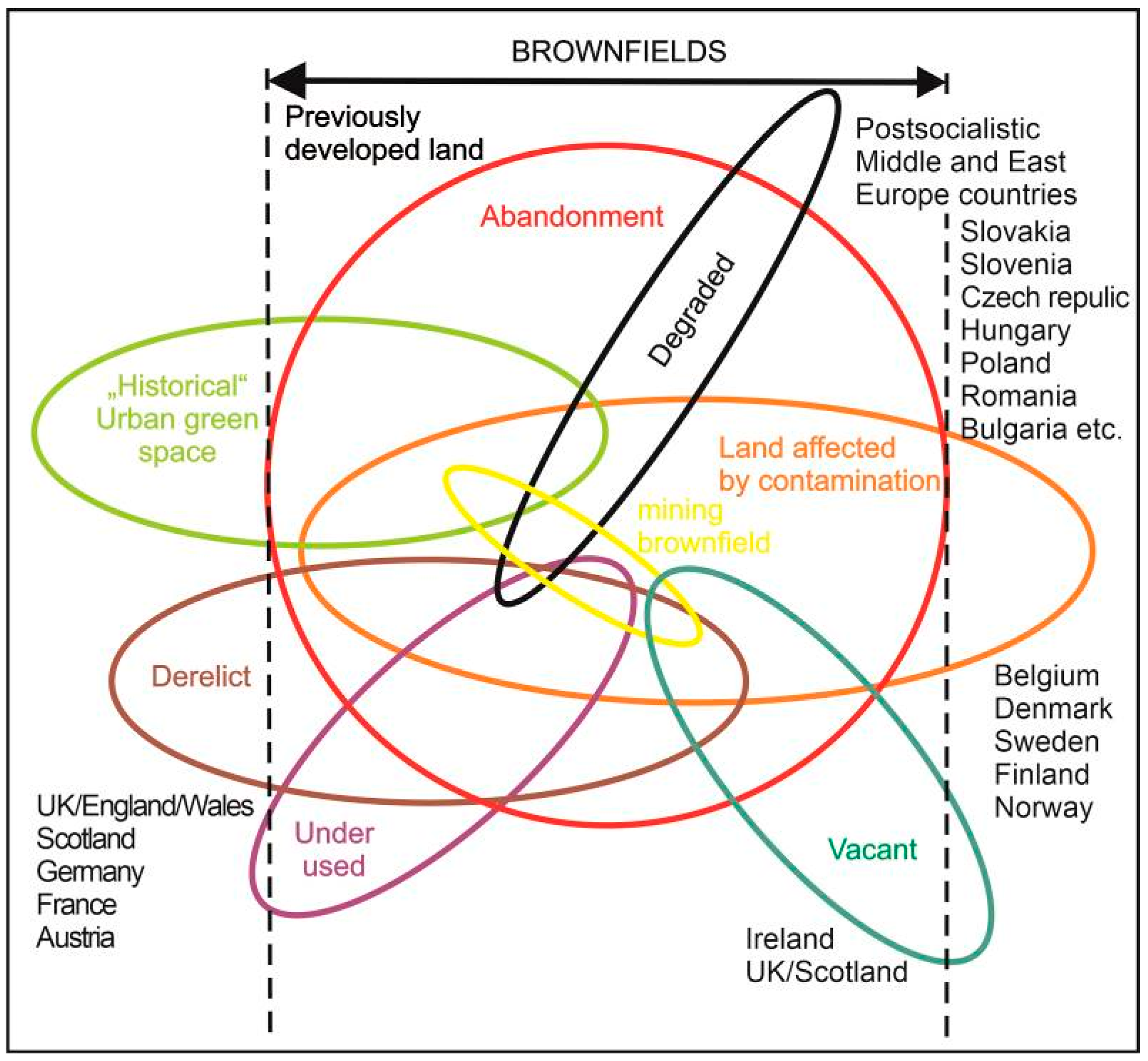
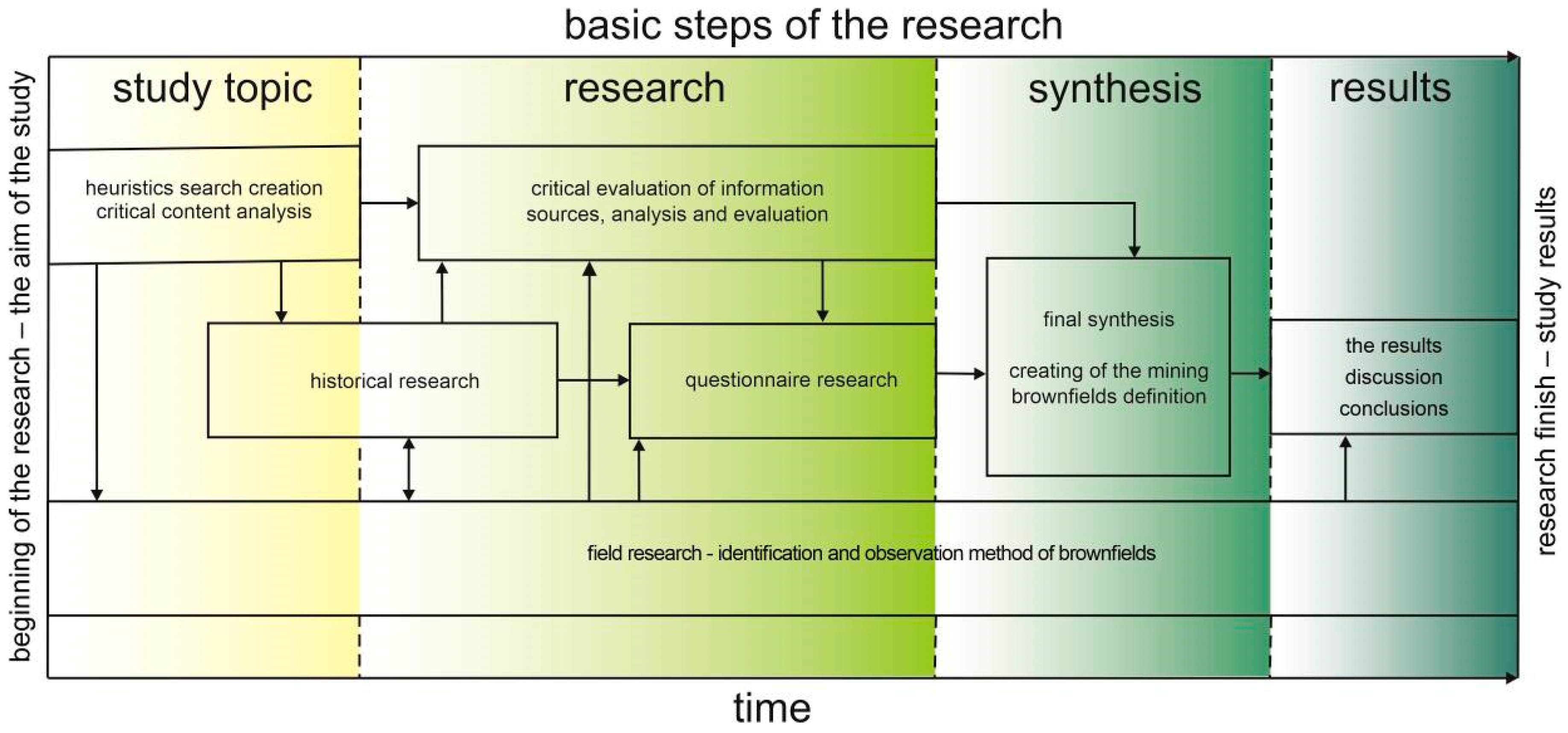
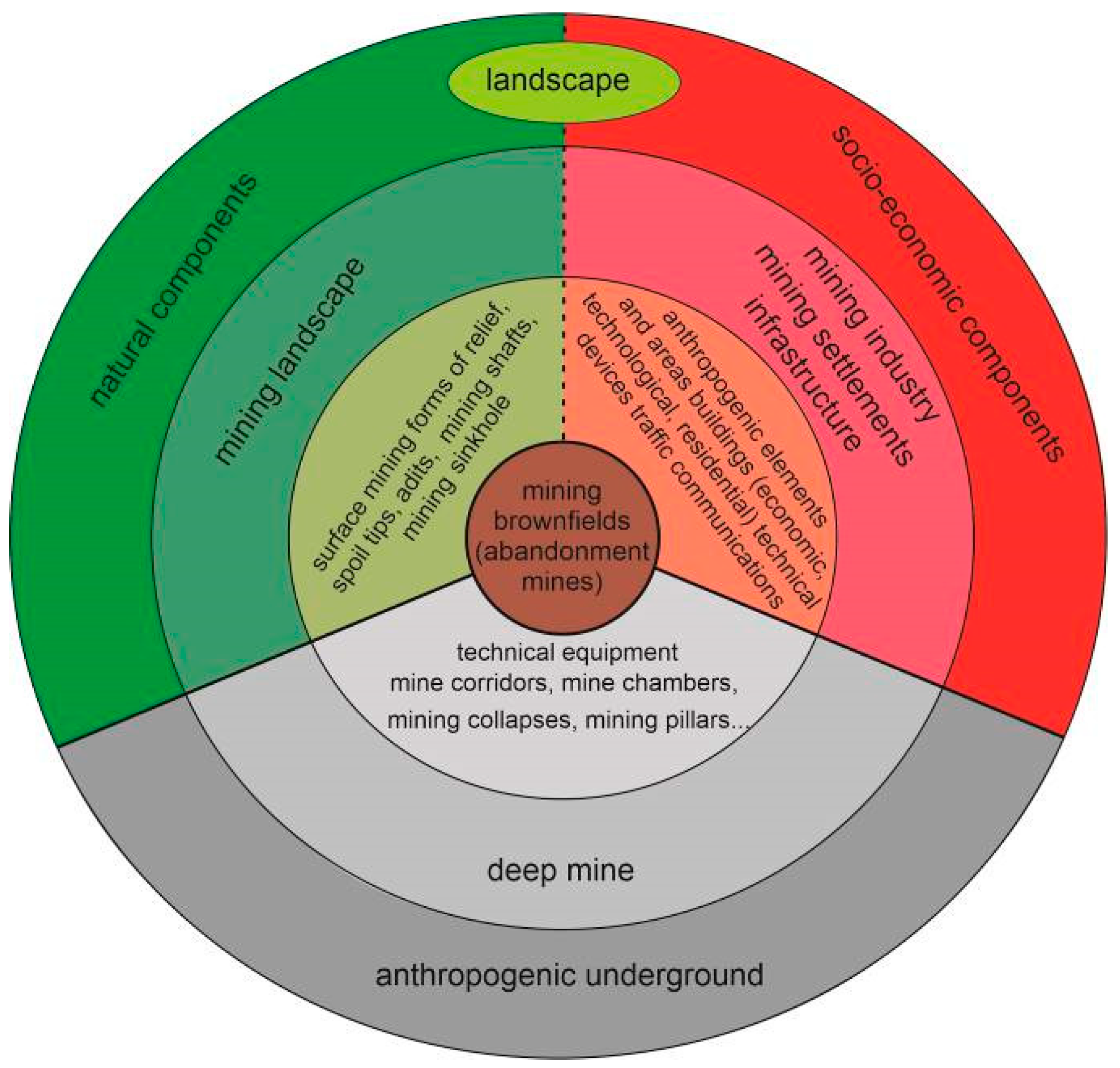




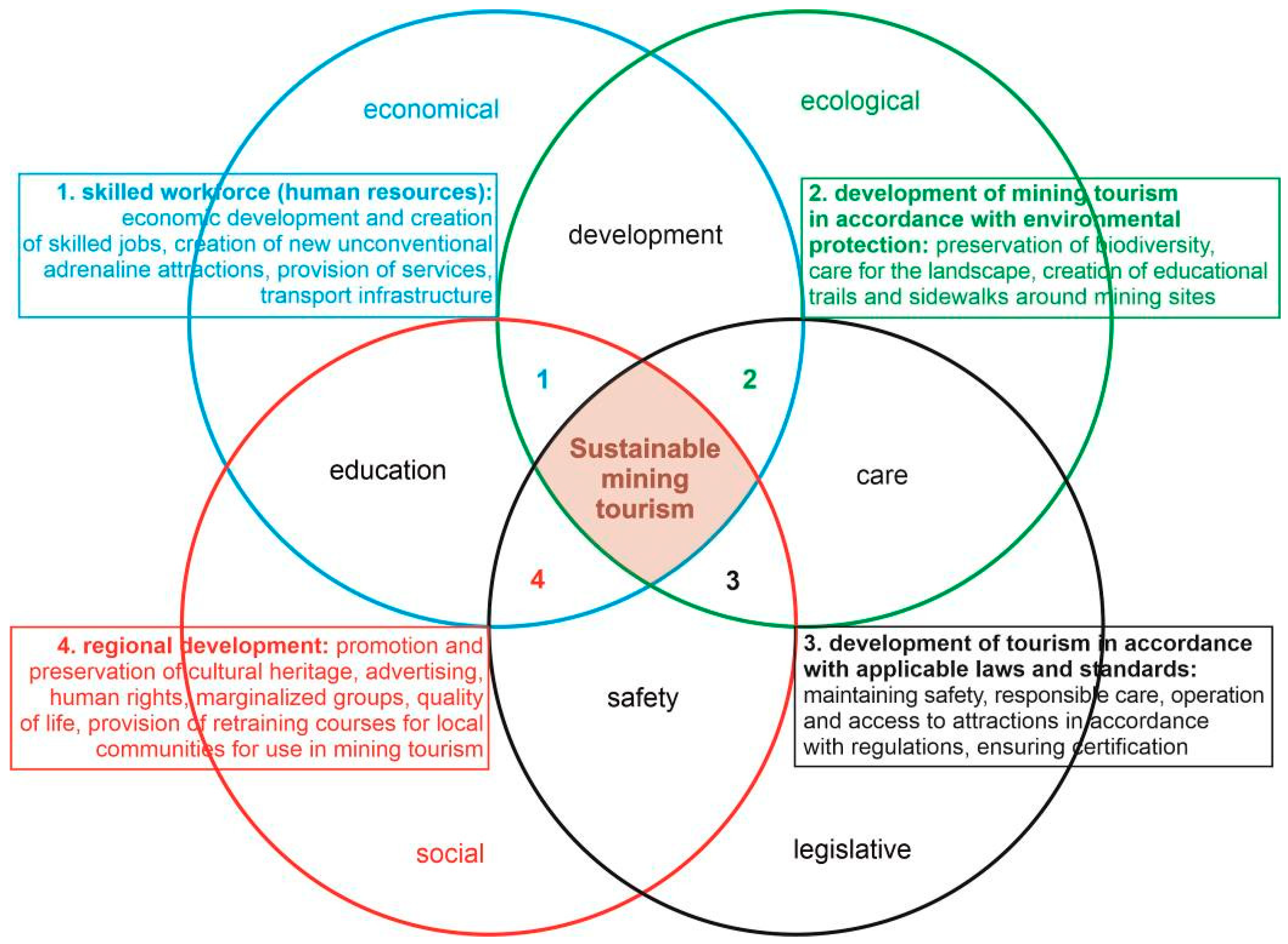
| Country | Authors | Definition |
|---|---|---|
| Europe | Ferber et al. (2006) [3] | “Currently derelict or underused sites which have been affected by former uses of the site or surrounding land; they are mainly located in fully or partly developed urban areas and may have real or perceived contamination problems thus require intervention to bring them back to beneficial use.” |
| CABERNET [1] | “A site that has been affected by former uses of the site or surrounding land, is derelict or underused, mainly in fully or partly developed urban areas, require intervention to bring it back to beneficial use; and may have real or perceived contamination problems.” | |
| UK | Post (1998) [4] | “Brownfield sites are buildings and land either now vacant, or that could become vacant or suitable for development, during a relevant [development] plan period.” |
| Ireland | Pavolová, Kyseľová, Bakalár (2012) [5] | “The abandoned areas-areas that have lost or losing their original character and negatively affect their environment due to their dilapidated, disrepair, or the presence of waste.” |
| Belgium-Wallonia | Pavolová et al. (2019) [6] | “Places formerly intended for economic recovery, where the status quo is not an efficient use of Flanders: An abandoned or underutilized industrial area with potential for active recovery or expansion, which is further complicated by the development of real or anticipated environmental problems.” |
| Belgium-Flanders | Oliver et al. (2005) [7] | “Abandoned or under used industrial sites with an active potential for redevelopment or expansion but where redevelopment or expansion is complicated by a real or perceived environmental contamination (legislation including a definition is in the process of approval).” |
| France | Darmendrail (1999) [8] | “A space that has been temporarily abandoned following the cessation of activity (agricultural, protoindustrial, service, processing, military defense, storage or transport) and that needs to be reclaimed for future use.” |
| Germany | Freier (1998) [9] | “Abandoned pieces of land, mainly in inner cities, which are often blocked for economic development due to their ecological and economic risks.” |
| Austria | Oliver et al. (2005) [7] | No official definition. Understanding similar to CABERNET definition recognising potential for reuse and with less focus on contamination. |
| Denmark, Finland, Sweden, Norway | Oliver et al. (2005) [7] Cehlár et al. (2019) [10] | “Degradated and contaminated areas.” |
| Italy | Pavolová et al. (2019) [6] | “Contaminated areas-areas that are chemically, physically or biologically contaminated in such a way that endangers human health or the surrounding buildings or landscape. The area is considered contaminated when contamination exceeds the limits set by law.” |
| Spain-Basque | Pavolová et al. (2019) [6] | “Potentially contaminated areas/derelict industrial buildings.” |
| USA | USEPA (2018) [11] | “Abandoned, idled, or under-used industrial and commercial facilities where expansion or redevelopment is complicated by real or perceived environmental contamination.” |
| Canada | De Sousa (2002) [12] | “Abandoned, idle or underused commercial or industrial sites where previous activities have caused environmental contamination, but where there is an active potential for redevelopment.” |
| Australia | Newton (2010) [13] | “A brownfield site is one which has been urbanized or used industrially, subsequently vacated and available for re-urbanization.” |
| South Africa | Potts and Cloete (2012) [14] | “A brownfield site is infill land or premises where remedial action is required before redevelopment. It may also be vacant, derelict or contaminated. No specific land use is attributed.” |
| Turkey | Mert (2019) [15] | “Brownfield is previously used land (or building) by another economic activity that is not currently used and is contaminated, abandoned or otherwise unoccupied. It can be found in rural or urban environments, and could usually be suitable for re-use, with or without intervention.” |
| Country | Authors | Definition |
|---|---|---|
| Czech republic | Vráblík (2009) [18]; Pavolová et al. (2019) [6] | “Brownfield is a property (land, building, complex), which is underused, neglected and may be contaminated. There is a remnant of the industrial, agricultural, residential, military or other activities. Brownfield is not used appropriately and effectively without the normal process of regeneration.” |
| Hungary | Pavolová et al. (2019) [6] | “The territory which had formerly been used economically efficient, but are currently underused, stopped. The main feature is the neglect, dereliction and contamination.” |
| Poland | Oliver et al. (2005) [7] | “Degraded areas due to diffuse soil contamination-high density of landfill sites.” |
| Bulgaria | Pavolová et al. (2019) [6] | “Contaminated land-areas in which previous activity has ceased, however, still have influence on their surroundings.” |
| Romania | Oliver et al. (2005) [7] | “Polluted lands (soils).” |
| Slovenia | Oliver et al. (2005) [7] | “Degradated/abandoned building land usually inside urban areas.” |
| Latvia | Oliver et al. (2005) [7] | “A place that has been previously used or built up, but currently is derelict or abandoned-can also be contaminated (adapted CABERNET definition).” |
| Russia-Siberia and Arctic | Cehlár et al. (2019) [10] | “(Mining) Browfields as potential areas for the resumption of mining using modern technological and environmental approaches with an emphasis on economic benefits for investors and local communities.” |
| Slovakia | Pavolová et al. (2019) [6] | “Brownfields can be various types of former industrial, commercial, transport and other logistics facilities, various technical infrastructure facilities, former landfills, areas affected by mining or other human activity and other unused facilities and lands that or partially or completely contaminated.” |
| Gregorová, Hronček, Tometzová, Molokáč, Čech (defined in this paper) | “Mining brownfields are understood as old mining and related areas, areas and buildings in the country (to a lesser extent in the urban area of settlements), which remained abandoned after mining, thereby losing their original use, or are little used and gradually decay. These areas are often associated with real or perceived contamination of the landscape and the environment.” |
Publisher’s Note: MDPI stays neutral with regard to jurisdictional claims in published maps and institutional affiliations. |
© 2020 by the authors. Licensee MDPI, Basel, Switzerland. This article is an open access article distributed under the terms and conditions of the Creative Commons Attribution (CC BY) license (http://creativecommons.org/licenses/by/4.0/).
Share and Cite
Gregorová, B.; Hronček, P.; Tometzová, D.; Molokáč, M.; Čech, V. Transforming Brownfields as Tourism Destinations and Their Sustainability on the Example of Slovakia. Sustainability 2020, 12, 10569. https://doi.org/10.3390/su122410569
Gregorová B, Hronček P, Tometzová D, Molokáč M, Čech V. Transforming Brownfields as Tourism Destinations and Their Sustainability on the Example of Slovakia. Sustainability. 2020; 12(24):10569. https://doi.org/10.3390/su122410569
Chicago/Turabian StyleGregorová, Bohuslava, Pavel Hronček, Dana Tometzová, Mário Molokáč, and Vladimír Čech. 2020. "Transforming Brownfields as Tourism Destinations and Their Sustainability on the Example of Slovakia" Sustainability 12, no. 24: 10569. https://doi.org/10.3390/su122410569
APA StyleGregorová, B., Hronček, P., Tometzová, D., Molokáč, M., & Čech, V. (2020). Transforming Brownfields as Tourism Destinations and Their Sustainability on the Example of Slovakia. Sustainability, 12(24), 10569. https://doi.org/10.3390/su122410569





